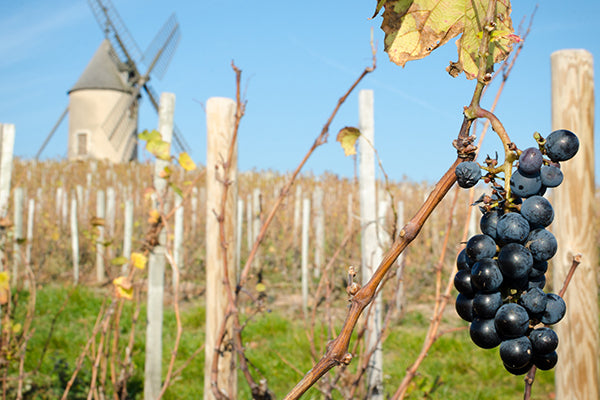Aromatic, complex, and unapologetically affordable, Beaujolais should not only be on your radar, but in your cellar.
These are wines of joy and purity. Born from a tradition of experimentation and innovation, they are a reminder that wine is a living thing.
Eric Asimov of the NY Times says it best: “Beaujolais, more than any other wine, connotes the sheer, elemental, joyous pleasure of wine for wine’s sake, rather than any of the other reasons people buy wine.”
Here are seven reasons why we love Cru Beaujolais and work hard to bring you the best examples at the best prices.

1. The golden age of Beaujolais.
You may not know it, but we’re living in the golden age of Beaujolais.
Long gone are the days when mass-market Beaujolais Nouveau defined the region. The steadfast work of the region’s leading winemakers, known as the Gang of Four—Marcel Lapierre, Guy Breton, Jean-Paul Thévenet, Jean Foillard and Yvon Métras—has put the Nouveau craze far in the rearview and established Beaujolais as wine to be savored, contemplated, and respected.
A focus on reaching full ripeness, organics in the vineyard, and minimal-interventionist winemaking underpin the transformation and have come to define the region today.
The paradigm, however, continues to shift.
The next generation of winemakers in the region, many of them the children of the original vignerons—Matthieu and Camille Lapierre, Alex Foilard, Jules Métras, Charly Thévenet—are pushing Beaujolais to the next level. No longer encumbered by the burden of proving the quality of Beaujolais, these producers are free to explore terroir in a real way.
The future of Beaujolais lives in the exploration of the rich and varied crus.

2. Terroir-driven wines.
Few regions in the world offer a better environment to explore the relationship between grape, environment, and winemaker.
Beaujolais is the ancestral home of the gamay grape. Aromatic and fruit-forward, with an undercurrent of minerality, gamay is an impressionable variety. Like a child of a parent, gamay speaks to where it comes from. It adapts to the smallest nuances in soils, elevations, climates, and sun exposures—elements that have been distinguished and isolated in the 10 crus of Beaujolais.
These sites have been singled out as the top wine producing areas in the region. Think of Burgundy, Champagne, and Piedmont—areas where microsites have been explored for centuries. The same thing is happening in Beaujolais.
The work of the region’s best winemakers demands that we view Beaujolais on the same level as the top regions in the world. Wine lovers that seek terroir-driven wines, made to express the purity of their place, will find a welcome home in Beaujolais.
3. Paradox of fruit and earth.
The best wines in the world—Burgundy and Barolo, as an example—offer a complexity of aroma that tantalize the senses and mind alike. These wines have an impossible balance of fruit, flower, and earth. If Barolo offers tar and roses, and Burgundy raspberries and wet earth, then Beaujolais conjures violets and granite.
It’s a paradox of flavor that is unmistakable and, once enjoyed, unforgettable.

4. Radical approach to winemaking.
The wines of Beaujolais are made in a way unlike anywhere else on earth. Carbonic maceration is a novel approach to fermentation that enhances the aromatics and freshness of the wine.
Fermentation happens within the grapes of whole, uncrushed bunches in a carbon dioxide rich environment. This reduces the juice’s exposure to tannin-rich skin, seeds, and pulp. The result? Wines that are fresh, spirited, and highly aromatic.
Carbonic maceration is now exported to New Zealand, Australia, Austria, the USA, and other regions in France such as the Rhone and Jura.
This unique approach to winemaking speaks to the history of innovation in the region. Beaujolais is an incubator for experimentation. The price of land, still affordable for most growers and producers, allows upstarts the opportunity to break into the industry.
The ultimate benefactor of this experimentation is the wine drinker.
5. Sommelier’s secret weapon.
Food-friendly doesn’t begin to capture the versatility of these wines. The high acidity, low alcohol, and soft tannins make Cru Beaujolais adaptable across cuisine, flavor, and occasion.
The wines have the elegance to go with classic dishes and the exuberance to stand up to your weekday favorites—burgers, pizza, tacos. The range in styles and textures can scale from slightly-chilled summer sippers to bold, structured wines on a cold, winter night.
These are wines that punch above their weight.

6. Workhorse of your cellar.
There are few places in the world where this level of elegance and complexity can be acquired at prices that won’t break the bank. The region’s top producers offer bottles in the $30 range with the top bottles going for under $50. The same wines in Burgundy demand 3-4x the price. For the seasoned wine collector, Beaujolais can be a great staple to stock your cellar.
7. Ageability
The greatest strength of this region—the immediate approachability of the wines—contributes to the misconception that the wines don’t age—a fact that might be true of general Beaujolais and Beaujolais Villages, but does not apply to Cru Beaujolais. Some of the most popular crus—Moulin-Á-Vent, Morgon, and Fleurie—can benefit from 3 years of bottle age and can live well past 10 years.
The region’s trademark of freshness and vibrant fruit will take on secondary characteristics of dried fruits, earth, meat, and spice.
Bottom Line
There are so many reasons to love Cru Beaujolais, but there’s one thing that keeps you coming back for more: these wines make you feel something. They have an essence that grabs you and won’t let go.
Where to Buy Cru Beaujolais Wines
The excellence of Cru Beaujolais wines are no longer a secret, evidenced by growing global demand, shrinking allocation, and rising prices. As such, determining where to buy Cru Beaujolais in the US can be a challenge. Thankfully, at Envoyer Fine Wines, we go straight to the source to secure a consistent allocation at top prices.
Buy: Cru Beaujolais Wines


